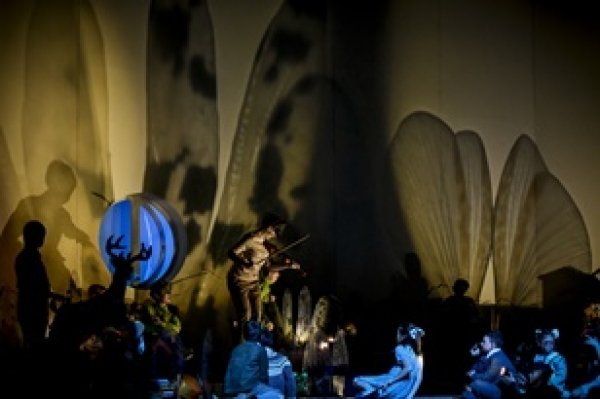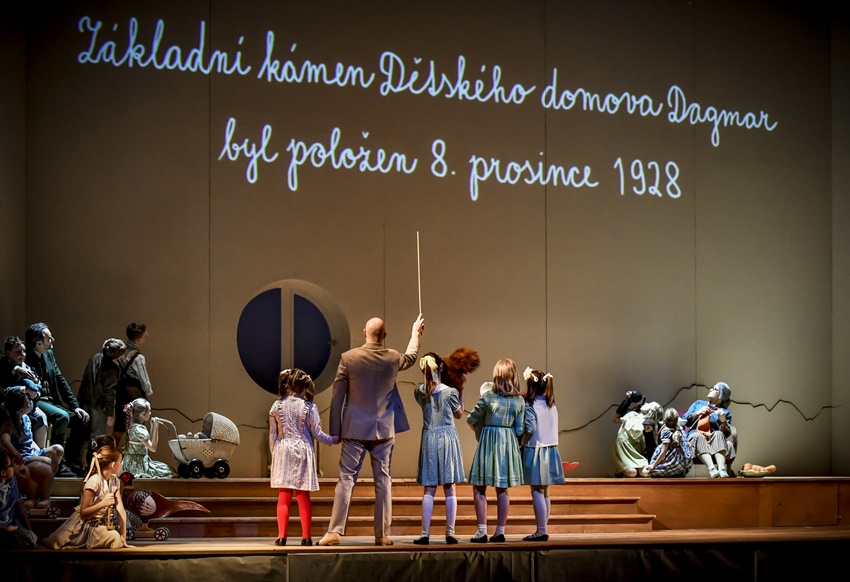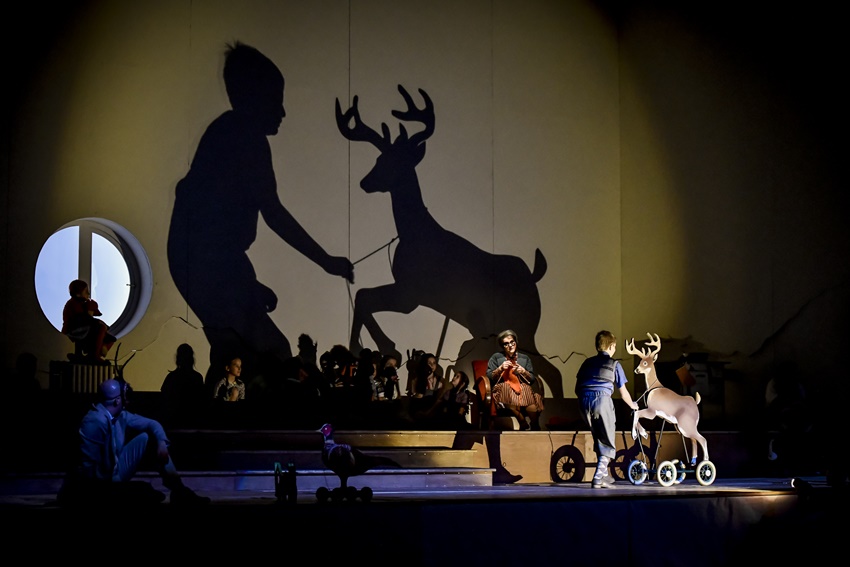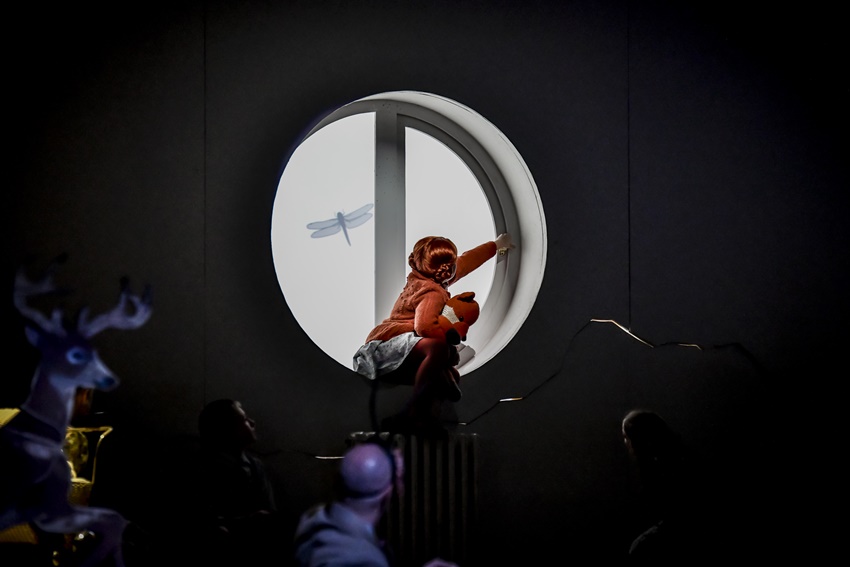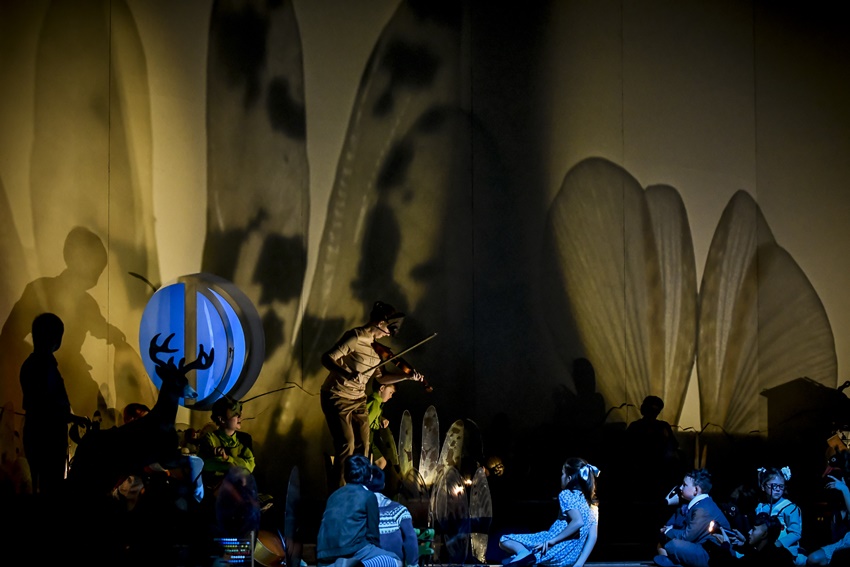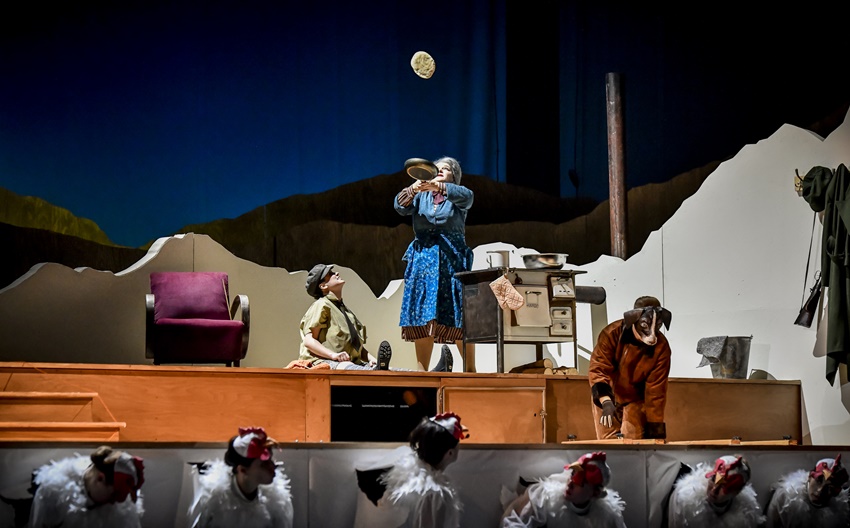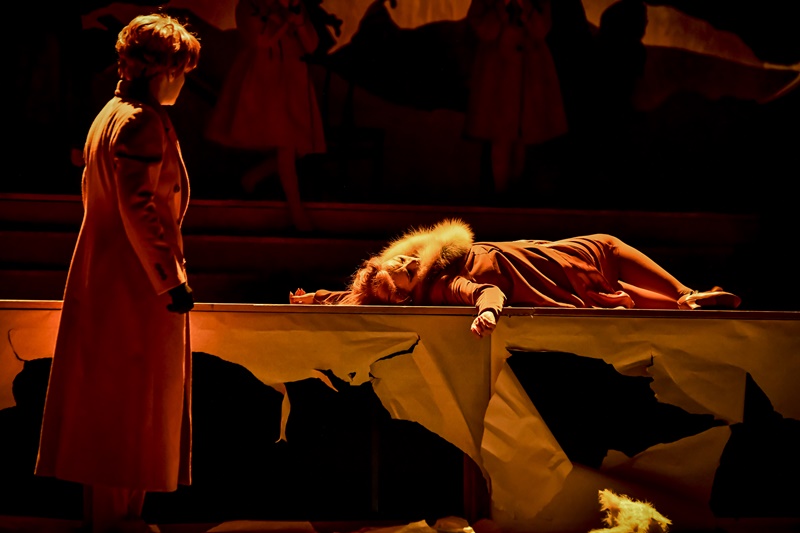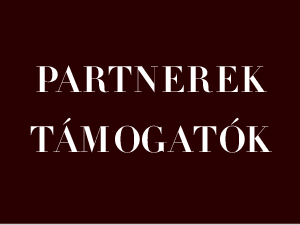Colour images from a book of fairy tales come to life on stage at the performance of Janáček's opera The cunning little vixen, directed by Jiří Heřman, at the Janáček Theatre in Brno. The piece is versatile and can be staged in several ways. Jiří Heřman's concept is one of them, but he brings this one to perfection. Besides the direction, the success of the production was guaranteed by the accomplished, authentic, sparkling performance of the company of the Janáček Theatre.
The cunning little vixen (original title: Příhody lišky Bystroušky) is the Czech composer Leoš Janáček's (1854-1928) seventh opera, premiered on November 6, 1924, at the National Theatre in Brno. The libretto, written by the composer, was based on a serial short story published by Rudolf Těsnohlídek in a Brno newspaper. The writing of Těsnohlídek was inspired by a series of drawings by the painter Stanislav Lolek, depicting a clever fox. Before World War II, the piece was popular only in Czechoslovakia and Germany, but then gradually conquered the stages of Europe's grand opera houses. The premiere of the work at the Hungarian State Opera House took place in 1979. The first recording of the opera was made in 1957 in Prague.
At Janáček's request, the music of the last scene of The cunning little vixen was played at his funeral in 1928. The Janáček Theatre opened its doors in 1965 with a performance of this work.
The story begins in a forest: a curious fox cub is chasing a frog into the lap of a forester dozing at the base of a tree. The forester forcibly takes the little vixen home, who, after growing up, escapes, falls in love with a fox, and they have fox cubs. At the same time, we get to know local people: in the inn, the forester, the pastor, and the schoolmaster are drinking and dreaming of a girl, the beautiful Terynka. The poacher, who has engaged Terynka, shoots the vixen in the woods. At the poacher's wedding, the forester sees the man giving the vixen's fur to his bride. He can't get the little animal out of his mind. He goes sadly into the woods, where a frog jumps on his lap: the grandson of the frog who did so at the beginning of the story. Transience is followed by renewal…
The cunning little vixen is certainly Janáček's most lyrical, melodic, and delightful late work. A hymn to nature, a reflection on the cycle of life and death, on the intertwining of man and nature, on love, on freedom. Its ambiguity and diversity also make it difficult to define its genre. It is a fairy tale, but not a tale for children; it is sad and deep, but not a tragedy; it is humorous and light, but not a comedy. We see two- and four-legged creatures walking their lives on the stage. They are not good or bad; they are both.
A few words about the title of the work. The original Czech title (Příhody lišky Bystroušky) refers to the adventures (or tales) of a vixen with 'pointed ears' (or being 'clever' or ' cunning'). The adjective 'little' is included only in the German and English translations (Das schlaue Füchslein and The cunning little vixen), and it also became part of the Hungarian translation through one of them.)
Janáček’s opera is always a challenge to stage it, as it connects two seemingly quite different worlds, each of which has enchanted the composer: man’s world and the world of nature.
Jiří Heřman's production is a well-thought-out, dynamic, aesthetically also impressive, stunning production.
This time, the first scene takes place in an orphanage. The house is filled with life by children. On the wall of its interior, in huge written letters, we read, 'The foundation stone of the Dagmar Children's Home was laid on December 8, 1928.' It is an imaginative association: the Dagmar Children's Home was founded on the initiative of Rudolf Těsnohlíd at the time (the writer whose short story inspired Janáček to compose the opera).
The three-level stage provides much flexibility. In addition, the back wall opens horizontally in the first act, as if a piece of paper was torn in two. This is the moment the young vixen, who is still in captivity, looks out into the dawn landscape from the yard of the forester's house, seeing the free world and noticing her later husband, the fox. The sight is dazzling. In the emerging, lavishly lit, idyllic landscape, we see cardboard trees, bushes, and mountains layered behind each other, which further enhances the sense of the depth of the stage.
Heřman uses the spaces of the stage with unprecedented ease and elegance. The scenes are put in a variety of places, sometimes unexpected for the viewer. There are several small objects – figures, objects of use – scattered around; by moving them a bit, and with the sophisticated play of the lights, the scene changes take place in moments, almost imperceptibly. At one moment, the interior of the forester's room appears; the next moment, a few metres away, the pub or the everyday life of the forest animals. The scenes almost melt into each other, and several events take place at the same time. There are no boring moments; the characters, including the passive ones, are constantly on the move in this lively production.
We see an eye-catching cavalcade of colourful costumes. Deers, crickets who play the violin, foxes, badgers, dung beetles, frogs, hens, hedgehogs, and humans populate the stage. Besides the paper figures, there are toy figures (animals) rolling on small wheels, pushed by the children, while the others carry stuffed animals in their laps. The adults, when representing animals, are in costumes and wear masks.
The silly hens are particularly funny in their white dresses with ruffled collars, watching excitedly the conflict between the rooster and the vixen from their chicken coop. The hilarious wedding scene of the foxes in the forest, getting married in front of a herd of animals with a cupcake tower, is also amusing.
Of course, this type of concept also has its drawbacks: the constant hustle and bustle sometimes distracts us from the events focused by the music and the libretto.
The performance is continued throughout by the motif of the dragonfly. The fragile insect symbolizes transience, but also renewal. There are magnificent, glittering creatures flying around gracefully. We see shadows of dragonflies projected on the walls and on the orphanage window, but also smaller and sometimes huge dragonfly wings on the ground, and everywhere.
It is less understandable why Ms. Revírníková, the forester's wife (who is a supporting character) is always present on the stage. She is usually knitting a red scarf that gets longer and longer, eventually reaching the ceiling (perhaps to illustrate the passage of time?). Other times she is cooking on her cooking-stove, and sometimes interacts with other characters, but not only with her husband, whom she punches with a pan but also with the foxes that are no longer nearby. But mostly she is knitting the scarf.
It is also difficult to explain why Harašta, the poacher with a rifle, shoots the vixen with a pistol.
The cunning little vixen is not a children's opera, but in this direction, it was. (There are also examples of directions that are more grim, more naturalistic, or that highlight the erotic attraction of the fox couple to each other, played by the two female singers.) There were a lot of excited kids in the auditorium, and while the death of the vixen must have been a long-lasting disappointment for many of them, they were watching the performance attentively throughout the whole evening.
It is well known that Janáček thoroughly analysed the melodies and rhythms found in everyday conversation, representing the emotions of the speaker, but also liked to record the sounds heard in nature. (He even studied the lives of foxes in preparation for the opera!) His observations also determine his musical style and language, not only in terms of the vocal parts but also in relation to the orchestral texture. In Janáček's translucent score, the frequent instrumental preludes and interludes not only form a transition between the scenes, but also play an important dramatic role. In these moments, the events and the narrative, as well as the characters' traits, are conveyed exclusively by the orchestra – sometimes as very short, simple musical motifs, because Janáček only needs a few instruments to create the necessary effect. He also uses Moravian folk music motifs and rhythm, while the depiction of nature evokes the music of Claude Debussy.
The orchestra of the Janáček Theatre in Brno, conducted by Marko Ivanović, interpreted the composer's music almost in studio quality. Their playing was characterized by varied tones, contrasting tempos, and, at the same time, by a uniform style. They described the characters' emotions and thoughts as expressively as the sounds, buzzes, noises, and atmosphere of the forest's wildlife. The balance of the instruments was ideal. The orchestral interludes were expressive and meaningful.
The singer soloists' performance was marked by stylish phrasing and clear diction. Their acting was devoted and spirited, their movements natural, without unnecessary pathos and affectations.
Jana Šrejma Kačírková, who played the Vixen, owns a powerful soprano voice with bright, ringing top notes. Her voice type is hard to define; she is a dramatic soprano, who is equally at home in the lyrical scenes. As the already grown-up Vixen, she tried to start a poultry revolution among the hens with humour and passion (but in vain) and drove the Badger out of his home with defiant vigour. Her feelings for the Fox were also nuanced: she was ecstatic in the love duet, but could also be tender and gentle. Her death made her a real 'heroine', and her last words to the poacher ('Shoot! Kill me! Just because I'm a fox?') remain memorable.
Singing the Forester's part, Jiří Sulženko, with his balanced, not very strong but pleasantly coloured baritone, was also one strength of the evening. Here, Janáček's portrayal is also complex. The man treats wild animals insensitively, but his gentler side soon shows up. And in the elevating, elegiac finale of the opera, when the aging man faces his own mortality, the baritone was moving.
High praise can be given to Jana Hrochová's rendition, too, in the role of the Fox. It should be noted, however, that although the part may be sung by a mezzo-soprano, it is better that this role is also given to a soprano, because it is written very high. No wonder Jana Hrochová forced her voice on the top notes, but was much more convincing in the lower register. (Interestingly, a tenor sang the role at the 1961 English premiere of the piece.)
The soloists mentioned were complemented by Jan Šťáva's dignified bass, who sang the Pastor, being in love hopelessly, and Petr Levíček's light buffo tenor, who interpreted the Schoolmaster, longing for the same girl. (The former also played the Badger and the latter the Mosquito.) Tadeáš Hoza's voice sounded fresh and vigorous in the role of Harasta, the Poacher.
The choir sang distinctly, and recognition goes to the child actors who played with discipline and seemingly with pleasure.
Balázs Csák
photo: Marek Olbrzymek
*
19 April 2022, National Theatre of Brno, Janáček Theatre
Leoš Janáček:
The cunning little vixen (Příhody lišky Bystroušky)
Opera in three acts, in Czech, with English and Czech surtitles
Libretto: Leoš Janáček based on the short story Liška Bystrouška by Rudolf Těsnohlídek
Set designer: Dragan Stojčevski
Costume designer: Alexandra Grusková
Lighting designer: Daniel Tesař
Dramaturg: Patricie Částková
Chorus master: Klára Složilová Roztočilová
Chorus master of the Children's Choir Brno: Valeria Maťašová
Stage director: Jiří Heřman
Cast:
Vixen: Jana Šrejma Kačírková
Fox: Jana Hrochová
The Little Vixen: Lucie Zerhauová
Forester: Jiří Sulženko
Schoolmaster / Mosquito: Petr Levíček
Pastor: Jan Šťáva
The Forester's Wife / Owl: Daniela Straková-Šedrlová
Pásek: Petr Karas
Mrs. Pásková / Woodpecker: Jitka Zerhauová
Pepík / Grasshopper: Barbora Garzinová
Frantik / Cricket: Eva Daňhelová
Harašta, poacher: Tadeáš Hoza
Lapák, the dogs: Jitka Klečanská
Cock / Jay: Alena Sobolová
The little frog: Vilém Langášek
Chocholka: Martina Mádlová
Featuring the Choir, Orchestra, and Ballet of the Janáček Theatre and the Children's Choir Brno
Conductor: Marko Ivanović


